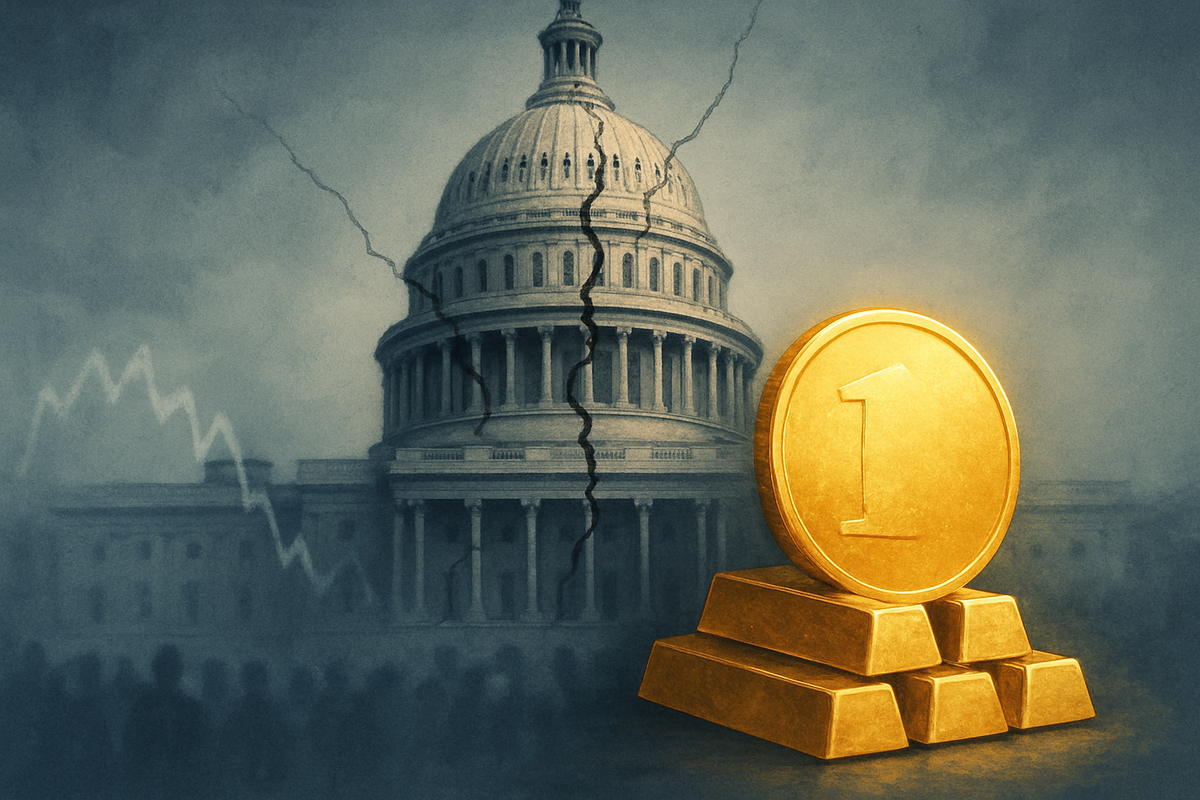
The United States federal government is currently grappling with a significant shutdown, which commenced on October 1, 2025, after Congress failed to enact critical funding legislation for the new fiscal year. This political stalemate, driven by deep partisan divisions, has immediately triggered widespread economic uncertainty, leading investors to flock to traditional safe-haven assets. Among these, gold has emerged as the clear beneficiary, with its price soaring to unprecedented levels as market participants seek refuge from the prevailing instability. As of October 3, 2025, gold prices have hit new all-time highs, reflecting heightened investor anxiety and a pessimistic outlook for the US dollar amid the ongoing political deadlock.
Unpacking the Standoff: Details, Timeline, and Market Tremors
The current US government shutdown began at 12:01 a.m. ET on October 1, 2025, marking the start of the 2026 fiscal year without approved appropriations. This is the third such shutdown under President Donald Trump's administration and the first significant one since the 2018-2019 fiscal dispute. The core of the impasse lies in deep partisan divisions, primarily centered around the Democratic Party's insistence on extending Affordable Care Act tax credits, a measure vehemently opposed by Republicans. With competing plans failing in the Senate and no immediate resolution in sight, the shutdown is projected to continue, prolonging the period of economic and market uncertainty.
The immediate fallout has been substantial. Approximately 750,000 federal employees have been furloughed without pay, leading to the suspension of non-essential government operations. While critical services like Medicare, Medicaid, and the Transportation Security Administration (TSA) continue to function, many employees in these vital sectors are working without compensation. This disruption extends to various public services, including national parks and passport processing, impacting citizens nationwide. A significant concern for financial markets is the delay or suspension of crucial economic data releases, such as the September employment report and weekly jobless claims. This "data blackout" leaves investors and policymakers, including the Federal Reserve, without essential metrics for informed decision-making, exacerbating the prevailing uncertainty.
Initial market reactions have been characterized by a pronounced "risk-off" sentiment. While historical data suggests that stock market reactions to shutdowns have often been temporary and relatively minor, the current environment is unique. Compounded by existing economic uncertainties, persistent inflation concerns, and a global slowdown in growth, this shutdown's impact could be more severe than previous episodes. The US dollar has shown weakness, continuing a year-to-date decline, as political instability erodes confidence. However, the most striking reaction has been in the gold market, where prices have surged dramatically. New York spot gold reached a record $3,858.45 per troy ounce just before the shutdown, with futures climbing towards $3,900. By October 3, spot gold had surpassed $3,890 per ounce, marking its third consecutive session of record highs and a 2.9% rise in US Dollar terms from the previous Friday, setting a fifth consecutive weekly record. This rally builds on a trend since 2024, with gold prices increasing 12% from $3,476 on September 1 to $3,895 a month later.
Companies Navigating the Storm: Winners and Losers
The ongoing government shutdown creates a distinct landscape of winners and losers across various industries, primarily dictated by their exposure to federal contracts, consumer spending, and the broader economic climate of uncertainty. Companies with direct reliance on government funding or regulatory approvals are likely to face significant headwinds, while those offering safe-haven alternatives or operating in less government-dependent sectors may see unexpected gains.
On the winning side, gold mining companies are experiencing a significant boon. As gold prices soar to record highs, companies involved in the extraction and production of gold stand to benefit directly from increased revenue and potentially wider profit margins. For instance, major players like Barrick Gold Corp. (NYSE: GOLD) and Newmont Corporation (NYSE: NEM) are seeing their stock values climb as investors seek exposure to the precious metal. The sustained demand for gold as a safe haven asset during periods of political and economic instability directly translates into a more favorable operating environment for these miners. Furthermore, companies that facilitate investment in gold, such as SPDR Gold Shares (NYSEARCA: GLD), an exchange-traded fund, are also likely to see increased inflows as retail and institutional investors alike move to hedge against uncertainty.
Conversely, a wide array of companies heavily reliant on government contracts or services are poised to suffer. Defense contractors, for example, may face delays in contract awards, payments, and project approvals. Companies like Lockheed Martin Corporation (NYSE: LMT) or Boeing Co. (NYSE: BA), which have substantial government dealings, could experience disruptions to their cash flow and project timelines. Similarly, any business providing services or products to furloughed federal agencies will see a sudden halt in demand. Beyond direct government ties, the broader economic uncertainty and reduced consumer spending resulting from furloughed workers and delayed economic data can ripple through the economy, impacting sectors like retail and hospitality. Companies like Amazon.com Inc. (NASDAQ: AMZN), which relies on robust consumer spending, or airlines such as Southwest Airlines Co. (NYSE: LUV), which could see reduced travel, might feel the pinch as consumer confidence wanes and disposable income decreases for a significant portion of the population. Financial services firms that rely on steady economic data for their operations or that have significant exposure to government-backed loans or programs could also face operational challenges and increased risk.
Wider Significance: A Crisis in Context
The current US government shutdown, and its profound impact on gold prices, is not an isolated incident but rather fits into a broader global trend of increasing political instability driving demand for safe-haven assets. This event underscores a growing investor apprehension regarding sovereign risk and the reliability of traditional financial instruments during periods of legislative gridlock. The "risk-off" sentiment permeating the markets is a clear signal that investors are prioritizing capital preservation over growth, a trend that has been intermittently observed in recent years amidst geopolitical tensions and economic uncertainties.
The ripple effects of this shutdown extend far beyond the immediate cessation of government services. On a macroeconomic level, the delay or suspension of critical economic data creates a "data blackout," hindering the Federal Reserve's ability to make informed monetary policy decisions. This lack of clarity can exacerbate market volatility and potentially lead to misjudgments in policy, with broader implications for interest rates, inflation, and overall economic growth. For competitors and partners, particularly those with significant exposure to the US economy, the uncertainty translates into reduced confidence, potential delays in trade agreements, and a general slowdown in cross-border economic activity. Industries heavily regulated by federal agencies will face operational delays and increased compliance risks as government functions are curtailed.
Historically, government shutdowns have often led to temporary dips in GDP and increased market volatility. However, the current situation is compounded by existing global economic fragility, persistent inflation concerns, and a generally slowing growth trajectory. Previous shutdowns, while disruptive, rarely triggered such an immediate and dramatic surge in gold prices to record highs. This suggests that the current political divisions are perceived as more entrenched, and the potential economic fallout more severe, by the market. For instance, the 2013 shutdown saw a modest increase in gold prices, but not to the unprecedented levels witnessed today. This time, the "perfect storm" of factors—deep political division, a pessimistic outlook for the US dollar, and expectations of further Federal Reserve rate cuts—has created an environment uniquely favorable for gold. The consideration by the Trump administration of permanent job cuts, rather than just furloughs, further amplifies the potential long-term economic fallout, distinguishing this event from many historical precedents.
What Comes Next: Navigating the Uncertainty
The path forward for the US economy and financial markets, particularly gold, hinges critically on the duration and resolution of the ongoing government shutdown. In the short term, as long as the political stalemate persists, the demand for safe-haven assets like gold is likely to remain elevated, potentially pushing prices even higher. Analysts are already speculating that gold could break the $4,000 per ounce mark by year-end if the uncertainty continues. The "data blackout" will continue to fuel market anxiety, as investors operate without crucial economic indicators, leading to increased volatility across asset classes.
Looking further ahead, the long-term implications are more complex. If the shutdown is protracted, it could inflict more significant and lasting damage on the US economy, potentially slowing GDP growth and undermining consumer confidence. This sustained economic weakness would likely reinforce gold's role as a store of value. However, a swift resolution, perhaps driven by public pressure or a bipartisan compromise, could lead to a temporary pullback in gold prices as risk appetite returns to the market. Despite any short-term corrections, the underlying factors that drove gold's rally—political instability, inflation concerns, and a weakening dollar—are unlikely to disappear entirely, suggesting that gold may maintain a higher baseline value than before the shutdown.
Potential strategic pivots for businesses and investors will be crucial. Companies with government contracts may need to diversify their client base or build larger cash reserves to weather future periods of federal funding uncertainty. For investors, the current environment underscores the importance of portfolio diversification, moving beyond solely US assets to include international equities, other stable currencies, and, critically, a continued allocation to precious metals. Market opportunities may emerge in sectors less exposed to government influence or those that benefit from economic uncertainty, such as certain technology companies or healthcare firms. Potential scenarios range from a quick, face-saving compromise leading to a modest market rebound, to a prolonged standoff that could trigger a more significant economic downturn and further solidify gold's position as a premier safe haven. The possibility of further Federal Reserve rate cuts, driven by economic weakness, would also serve as a tailwind for gold.
Wrap-Up: Gold's Enduring Luster in Turbulent Times
The ongoing US government shutdown serves as a potent reminder of the profound impact political instability can have on financial markets and investor sentiment. The immediate and most striking takeaway is the unprecedented surge in gold prices, which have reached record highs as investors flock to the precious metal for safety. This event vividly illustrates gold's enduring role as a quintessential safe-haven asset, particularly when traditional economic indicators are obscured by a "data blackout" and the reliability of government institutions is called into question.
Moving forward, the market remains highly sensitive to developments in Washington. While a resolution to the shutdown could bring some temporary relief and potentially a modest correction in gold prices, the underlying anxieties that fueled this rally are likely to persist. The current episode has highlighted deep-seated political divisions and economic vulnerabilities that are not easily resolved, suggesting a new baseline of heightened uncertainty in the financial landscape. Investors should anticipate continued volatility across markets, with a persistent lean towards assets perceived as stable and uncorrelated with broader economic fluctuations.
The lasting impact of this shutdown could be a recalibration of investment strategies, with a greater emphasis on diversification and hedging against political risk. What investors should watch for in the coming months includes not only the progress of legislative negotiations but also the long-term economic data once it becomes available, the Federal Reserve's response to economic weakness, and any shifts in global geopolitical stability. The current environment reinforces the notion that gold is not merely an inflationary hedge but a crucial component of a resilient portfolio in an increasingly unpredictable world.
This content is intended for informational purposes only and is not financial advice





